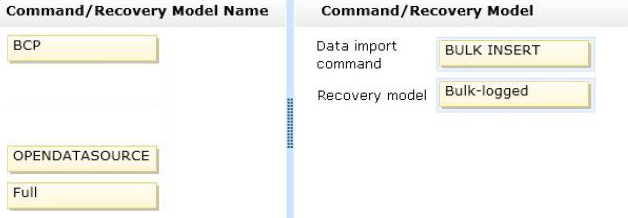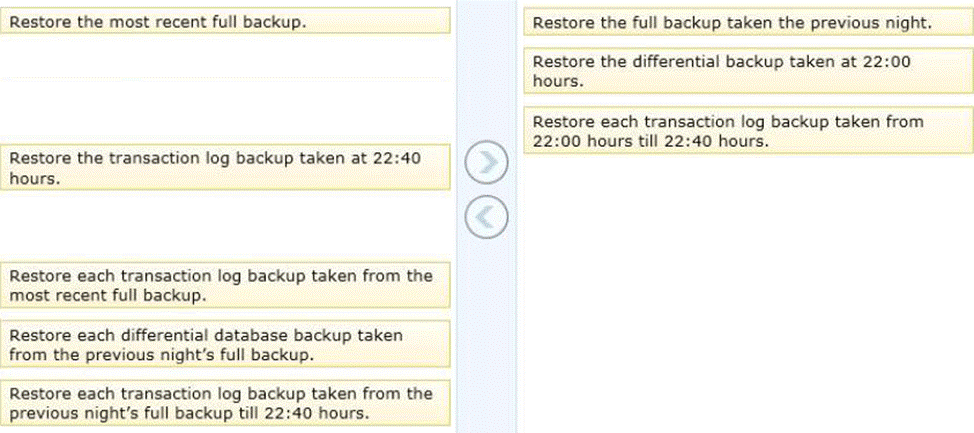Microsoft 70-462 Administering Microsoft SQL Server 2012 Databases Online Training
Microsoft 70-462 Online Training
The questions for 70-462 were last updated at Dec 13,2025.
- Exam Code: 70-462
- Exam Name: Administering Microsoft SQL Server 2012 Databases
- Certification Provider: Microsoft
- Latest update: Dec 13,2025
You administer a Microsoft SQL Server instance that contains a financial database hosted on a storage area network (SAN).
The financial database has the following characteristics:
– A data file of 2 terabytes is located on a dedicated LUN (drive D).
– A transaction log of 10 GB is located on a dedicated LUN (drive E).
– Drive D has 1 terabyte of free disk space.
– Drive E has 5 GB of free disk space.
The database is continually modified by users during business hours from Monday through Friday between 09:00 hours and 17:00 hours. Five percent of the existing data is modified each day.
The Finance department loads large CSV files into a number of tables each business day at 11:15 hours and 15:15 hours by using the BCP or BULK INSERT commands. Each data load adds 3 GB of data to the database.
These data load operations must occur in the minimum amount of time.
A full database backup is performed every Sunday at 10:00 hours. Backup operations will be performed every two hours (11:00, 13:00, 15:00, and 17:00) during business hours.
On Wednesday at 10:00 hours, the development team requests you to refresh the database on a development server by using the most recent version.
You need to perform a full database backup that will be restored on the development server.
Which backup option should you use?
- A . NORECOVERY
- B . FULL
- C . NO_CHECKSUM
- D . CHECKSUM
- E . Differential
- F . 8ULK_LOGGED
- G . STANDBY
- H . RESTART
- I . SKIP
- J . Transaction log
- K . DBO ONLY
- L . COPY_ONLY
- M . SIMPLE
- N . CONTINUE AFTER ERROR
You administer a Microsoft SQL Server 2012 instance that contains a financial database hosted on a storage area network (SAN).
The financial database has the following characteristics:
– A data file of 2 terabytes is located on a dedicated LUN (drive D).
– A transaction log of 10 GB is located on a dedicated LUN (drive E).
– Drive D has 1 terabyte of free disk space.
– Drive E has 5 GB of free disk space.
The database is continually modified by users during business hours from Monday through Friday between 09:00 hours and 17:00 hours. Five percent of the existing data is modified each day.
The Finance department loads large CSV files into a number of tables each business day at 11:15 hours and 15:15 hours by using the BCP or BULK INSERT commands. Each data load adds 3 GB of data to the database.
These data load operations must occur in the minimum amount of time.
A full database backup is performed every Sunday at 10:00 hours. Backup operations will be performed every two hours (11:00, 13:00, 15:00, and 17:00) during business hours.
You need to ensure that the minimum amount of data is lost.
Which recovery model should the database use?
- A . FULL
- B . DBO_ONLY
- C . CONTINUE_AFTER_ERROR
- D . CHECKSUM
- E . NO_CHECKSUM
- F . SIMPLE
- G . Transaction log
- H . SKIP
- I . RESTART
- J . COPY_ONLY
- K . NORECOVERY
- L . BULK_LOGGED
- M . Differential
- N . STANDBY
You administer a Microsoft SQL Server instance that contains a financial database hosted on a storage area network (SAN).
The financial database has the following characteristics:
– A data file of 2 terabytes is located on a dedicated LUN (drive D).
– A transaction log of 10 GB is located on a dedicated LUN (drive E).
– Drive D has 1 terabyte of free disk space.
– Drive E has 5 GB of free disk space.
The database is continually modified by users during business hours from Monday through Friday between 09:00 hours and 17:00 hours. Five percent of the existing data is modified each day.
The Finance department loads large CSV files into a number of tables each business day at 11:15 hours and 15:15 hours by using the BCP or BULK INSERT commands. Each data load adds 3 GB
of data to the database.
These data load operations must occur in the minimum amount of time.
A full database backup is performed every Sunday at 10:00 hours. Backup operations will be performed every two hours (11:00, 13:00, 15:00, and 17:00) during business hours.
You need to ensure that the backup size is as small as possible.
Which backup should you perform every two hours?
- A . BULK_LOGGED
- B . NO_CHECKSUM
- C . FULL
- D . RESTART
- E . CHECKSUM
- F . STANDBY
- G . DBO_ONLY
- H . NORECOVERY
- I . SIMPLE
- J . SKIP
- K . Transaction log
- L . COPY_ONLY
- M . Differential
- N . CONTINUE_AFTER_ERROR
Topic 2, Exam Pool B
You administer a Microsoft SQL Server instance named SQL2012 that hosts an OLTP database of 1 terabyte in size.
The database is modified by users only from Monday through Friday from 09:00 hours to 17:00 hours. Users modify more than 30 percent of the data in the database during the week.
Backups are performed as shown in the following schedule:

The Finance department plans to execute a batch process every Saturday at 09:00 hours. This batch process will take a maximum of 8 hours to complete.
The batch process will update three tables that are 10 GB in size. The batch process will update these tables multiple times.
When the batch process completes, the Finance department runs a report to find out whether the batch process has completed correctly.
You need to ensure that if the Finance department disapproves the batch process, the batch operation can be rolled back in the minimum amount of time.
What should you do on Saturday?
- A . Perform a differential backup at 08:59 hours.
- B . Record the LSN of the transaction log at 08:59 hours. Perform a transaction log backup at 17:01 hours.
- C . Create a database snapshot at 08:59 hours.
- D . Record the LSN of the transaction log at 08:59 hours. Perform a transaction log backup at 08:59 hours.
- E . Create a marked transaction in the transaction log at 08:59 hours. Perform a transaction log backup at 17:01 hours.
- F . Create a marked transaction in the transaction log at 08:59 hours. Perform a transaction log backup at 08:59 hours.
You administer a Microsoft SQL Server 2012 instance.
The instance contains a database that supports a retail sales application. The application generates hundreds of transactions per second and is online 24 hours per day and 7 days per week.
You plan to define a backup strategy for the database.
You need to ensure that the following requirements are met:
– No more than 5 minutes worth of transactions are lost.
– Data can be recovered by using the minimum amount of administrative effort.
What should you do? Choose three.
- A . Configure the database to use the SIMPLE recovery model.
- B . Create a DIFFERENTIAL database backup every 4 hours.
- C . Create a LOG backup every 5 minutes.
- D . Configure the database to use the FULL recovery model.
- E . Create a FULL database backup every 24 hours.
- F . Create a DIFFERENTIAL database backup every 24 hours.
You administer a Microsoft SQL Server 2012 database that contains a table named OrderDetail. You discover that the NCI_OrderDetail_CustomerID non-clustered index is fragmented.
You need to reduce fragmentation. You need to achieve this goal without taking the index offline.
Which Transact-SQL batch should you use?
- A . CREATE INDEX NCI_OrderDetail_CustomerID ON OrderDetail.CustomerIDWITH DROP EXISTING
- B . ALTER INDEX NCI_OrderDetail_CustomerID ON OrderDetail.CustomerIDREORGANIZE
- C . ALTER INDEX ALL ON OrderDetailREBUILD
- D . ALTER INDEX NCI_OrderDetail_CustomerID ON OrderDetail.CustomerIDREBUILD
You administer a Microsoft SQL Server database named Sales. The database is 3 terabytes in size.
The Sales database is configured as shown in the following table.
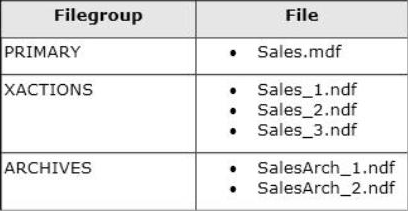
You discover that all files except Sales_2.ndf are corrupt. You need to recover the corrupted data in the minimum amount of time.
What should you do?
- A . Perform a file restore.
- B . Perform a transaction log restore.
- C . Perform a restore from a full backup.
- D . Perform a filegroup restore.
DRAG DROP
You administer a Microsoft SQL Server 2012 database.
The database uses SQL Server Agent jobs to perform regular FULL and LOG backups. The database uses the FULL recovery model. You plan to perform a bulk import of a very large text file.
You need to ensure that the following requirements are met during the bulk operation:
– The database transaction log is minimally affected.
– The database is online and all user transactions are recoverable.
– All transactions are fully recoverable prior to the import.
Which three actions should you perform in sequence? (To answer, move the appropriate actions from the list of actions to the answer area and arrange them in the correct order.)

DRAG DROP
You administer a Microsoft SQL Server database.
You want to import data from a text file to the database.
You need to ensure that the following requirements are met:
– Data import is performed by using a stored procedure.
– Data is loaded as a unit and is minimally logged.
Which data import command and recovery model should you choose? (To answer, drag the appropriate data import command or recovery model to the appropriate location or locations in the answer area. Each data import command or recovery model may be used once, more than once, or not at all. You may need to drag the split bar between panes or scroll to view content.)
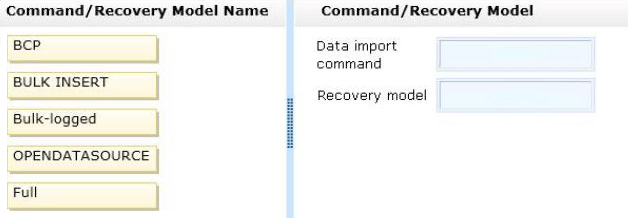
DRAG DROP
You administer a Microsoft SQL Server database.
The database is backed up according to the following schedule:
– Daily full backup at 23:00 hours.
– Differential backups on the hour, except at 23:00 hours.
– Log backups every 10 minutes from the hour, except on the hour.
The database uses the Full recovery model. A developer accidentally drops a number of tables and stored procedures from the database between 22:40 hours and 23:10 hours. You perform a database restore at 23:30 hours to recover the dropped table.
You need to restore the database by using the minimum amount of administrative effort. You also need to ensure minimal data loss.
Which three actions should you perform in sequence? (To answer, move the appropriate actions from the list of actions to the answer area and arrange them in the correct order.)
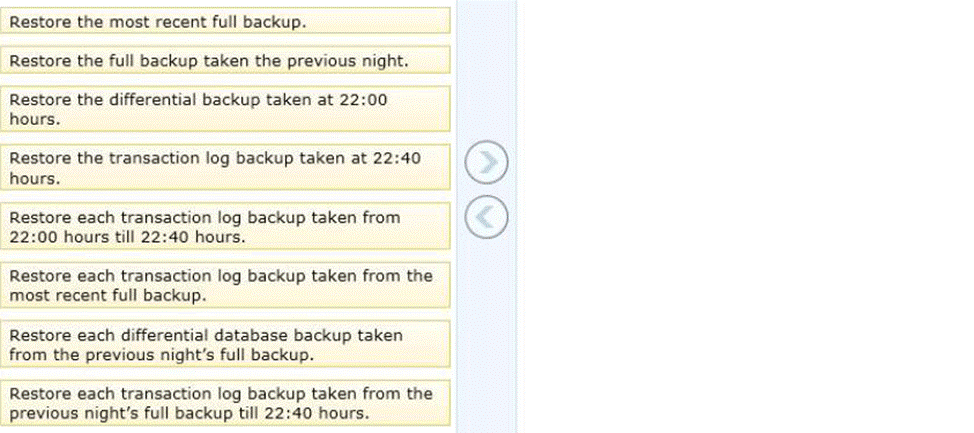
Latest 70-462 Dumps Valid Version with 301 Q&As
Latest And Valid Q&A | Instant Download | Once Fail, Full Refund


